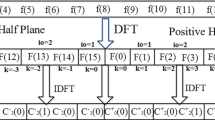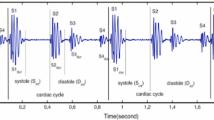Abstract
DFT-based complex harmonic wavelet (CHW) is being used to directly compute frequency content with respect to time by employing discrete Fourier transform and inverse discrete Fourier transform. However, DFT coefficients suffer severe leakage of energy from one band to another band of frequency. To minimize the leakage between bands, a new basis function for harmonic wavelet transform using discrete cosine transform (DCTHWT) is proposed, which leads to a better representation of the time-frequency spectrum. The proposed DCTHWT bases are formulated by multiplying DCT-II matrix with a block diagonal matrix in which blocks are phase multiplied DCT-II matrices. The time-frequency analysis using the proposed DCTHWT is studied for different non-stationary input signals, and observed that leakages are minimized compared to the spectrogram, computed using DFT-based CHW. In addition to the aforesaid advantage, the proposed wavelet transform has features like admissibility, orthogonality, multiresolution and band-limited nature in the frequency domain. Further, the computational complexity of the proposed DCT-based harmonic wavelet transform is studied and observed that it has asymptotic gain of \(50 \%\) compared to CHW and \(33 \%\) compared to the modified CHW. Hence, the proposed DCT-based HWT is efficient in terms of computational complexity and have better time-frequency representation compared to DFT-based complex harmonic wavelet transform.










Similar content being viewed by others
Data Availability
The data that supports the findings of this study are available within the article.
Code Availability
Not applicable.
References
Luo, Y., & Wang, Y. (2020). A statistical time-frequency model for non-stationary time series analysis. IEEE Transactions on Signal Processing, 68, 4757–4772.
Pagana, G., Galleani, L., Gross, S., Roch, M. R., Pastore, E., Poggio, M., & Quaranta, G. (2012). Time-frequency analysis of the endocavitarian signal in paroxysmal atrial fibrillation. IEEE Transactions on Biomedical Engineering, 59, 2838–2844.
Tadel, F., Baillet, S., Mosher, J. C., Pantazis, D., & Leahy, R. M. (2011). Brainstorm: a user-friendly application for MEG/EEG analysis. Computational Intelligence and Neuroscience, 2011, 8.
Cho, S. -H., Jang, G., & Kwon, S. -H. (2010). Time-frequency analysis of power-quality disturbances via the Gabor-Wigner transform. IEEE Transactions on Power Delivery, 25, 494–499.
Lin, Y. -H., & Tsai, M. -S. (2013). Development of an improved time-frequency analysis-based nonintrusive load monitor for load demand identification. IEEE Transactions on Instrumentation and Measurement, 63, 1470–1483.
Leonowicz, Z., Lobos, T., & Sikorski, T. (2007). Time-frequency analysis of complex space phasor in power electronics. IEEE Transactions on Instrumentation and Measurement, 56, 2395–2403.
Li, Z., Gao, J., Wang, Z., Liu, N., & Yang, Y. (2020). Time-synchroextracting general chirplet transform for seismic time-frequency analysis. IEEE Transactions on Geoscience and Remote Sensing, 58, 8626–8636.
Liu, N., Gao, J., Zhang, B., Li, F., & Wang, Q. (2017). Time-frequency analysis of seismic data using a three parameters s transform. IEEE Geoscience and Remote Sensing Letters, 15, 142–146.
Liu, W., Cao, S., & Chen, Y. (2016). Seismic time-frequency analysis via empirical wavelet transform. IEEE Geoscience and Remote Sensing Letters, 13, 28–32.
Guo, K. -Y., Qu, Q. -Y., Feng, A. -X., & Sheng, X. -Q. (2016). Miss distance estimation based on scattering center model using time-frequency analysis. IEEE Antennas and Wireless Propagation Letters, 15, 1012–1015.
Zhang, Y., Amin, M., & Ahmad, F. (2008). Time-frequency analysis for the localization of multiple moving targets using dual-frequency radars. IEEE Signal Processing Letters, 15, 777–780.
Li, Z., & Crocker, M. J. (2006). A study of joint time-frequency analysis-based modal analysis. IEEE Transactions on Instrumentation and Measurement, 55, 2335–2342.
Gabor, D. (1946). Theory of communication. Part 1: the analysis of information. Journal of the Institution of Electrical Engineers - Part III: Radio and Communication Engineering, 93, 429–441.
Dremin, I. M., Ivanov, O. V., & Nechitailo, V. A. (2001). Wavelets and their uses. Physics-Uspekhi, 44, 447.
Newland, D. E. (1993). Harmonic wavelet analysis. Proceedings of the Royal Society of London, Series A: Mathematical and Physical Sciences, 443, 203–225.
Khatua, P., & Ray, K. C. (2022). A low computational complexity modified complex harmonic wavelet transform. Circuits, Systems, and Signal Processing, 1–22.
Harris, F. J. (1978). On the use of windows for harmonic analysis with the discrete Fourier transform. Proceedings of the IEEE, 66, 51–83.
Schuster, S., Scheiblhofer, S., & Stelzer, A. (2009). The influence of windowing on bias and variance of DFT-based frequency and phase estimation. IEEE Transactions on Instrumentation and Measurement, 58, 1975–1990.
Narasimhan, S., Harish, M., Haripriya, A., & Basumallick, N. (2009). Discrete cosine harmonic wavelet transform and its application to signal compression and subband spectral estimation using modified group delay. Signal, Image and Video Processing, 3, 85–99.
Narasimha, M., & Peterson, A. (1978). On the computation of the discrete cosine transform. IEEE Transactions on Communications, 26, 934–936.
Kim, S., Yu, H., Lee, J., & Hong, D. (2009). Low bias frequency domain SNR estimator using DCT in mobile fading channels. IEEE Transactions on Wireless Communications, 8, 45–50.
Jiang, J., & Feng, G. (2002). The spatial relationship of DCT coefficients between a block and its sub-blocks. IEEE Transactions on Signal Processing, 50, 1160–1169.
Sang, Y. -F. (2012). A practical guide to discrete wavelet decomposition of hydrologic time series. Water Resources Management, 26, 3345–3365.
Yang, M., Sang, Y. -F., Liu, C., & Wang, Z. (2016). Discussion on the choice of decomposition level for wavelet based hydrological time series modeling. Water, 8, 197.
Walter, G. G., & Zhang, J. (1998). Orthonormal wavelets with simple closed-form expressions. IEEE Transactions on Signal Processing, 46, 2248–2251.
Zayed, A. I., & Walter, G. G. (2001). Wavelets in closed forms. In Wavelet Transforms and Time-Frequency Signal Analysis (pp. 121–143). Springer.
Shao, X., & Johnson, S. G. (2008). Type-II/III DCT/DST algorithms with reduced number of arithmetic operations. Signal Processing, 88, 1553–1564.
Chen, W. -H., Smith, C., & Fralick, S. (1977). A fast computational algorithm for the discrete cosine transform. IEEE Transactions on Communications, 25, 1004–1009.
Kaplun, D., Voznesenskiy, A., Romanov, S., Nepomuceno, E., & Butusov, D. (2019). Optimal estimation of wavelet decomposition level for a matching pursuit algorithm. Entropy, 21, 843.
Tsui, P. P., & Basir, O. A. (2006). Wavelet basis selection and feature extraction for shift invariant ultrasound foreign body classification. Ultrasonics, 45, 1–14.
Acknowledgements
The authors would like to thank Deity, GOI for partially using the utilities provided under \(SMDP-C2SD\), Electrical Engineering Department \((R \& D/SP/EE/SMD/2015-16/126)\).
Author information
Authors and Affiliations
Corresponding author
Ethics declarations
Conflicts of Interest
The authors declare that they have no conflict of interest.
Additional information
Publisher's Note
Springer Nature remains neutral with regard to jurisdictional claims in published maps and institutional affiliations.
Appendix
Appendix
1.1 A. Derivation of the Proposed DCTHWT Basis Function
The proposed DCTHWT equation in (15) is derived for \(i_o >0\) in (13). Equation (13) is expressed excluding the constant term as
The first term in (26) is termed as \(T_1\) and expressed as
With the help of trigonometric identity, (27) is defined as
Equation (27) is derived with the help of (28) as
Similar to (29), the second term in (26) is obtained as
Combining the value of (29) and (30), \(\psi '_{[i_o, \tau ]}(n)\) in (26) is obtained as
1.2 B. Derivation of \(\sum _{m=1}^{n-2}\limits m 2^{m}\)
The term \(\sum _{m=1}^{n-2}\limits m 2^{m}\) is computed as
Rights and permissions
Springer Nature or its licensor holds exclusive rights to this article under a publishing agreement with the author(s) or other rightsholder(s); author self-archiving of the accepted manuscript version of this article is solely governed by the terms of such publishing agreement and applicable law.
About this article
Cite this article
Khatua, P., Ray, K.C. An Efficient DCT-II Based Harmonic Wavelet Transform for Time-Frequency Analysis. J Sign Process Syst 94, 1381–1394 (2022). https://doi.org/10.1007/s11265-022-01805-z
Received:
Revised:
Accepted:
Published:
Issue Date:
DOI: https://doi.org/10.1007/s11265-022-01805-z




